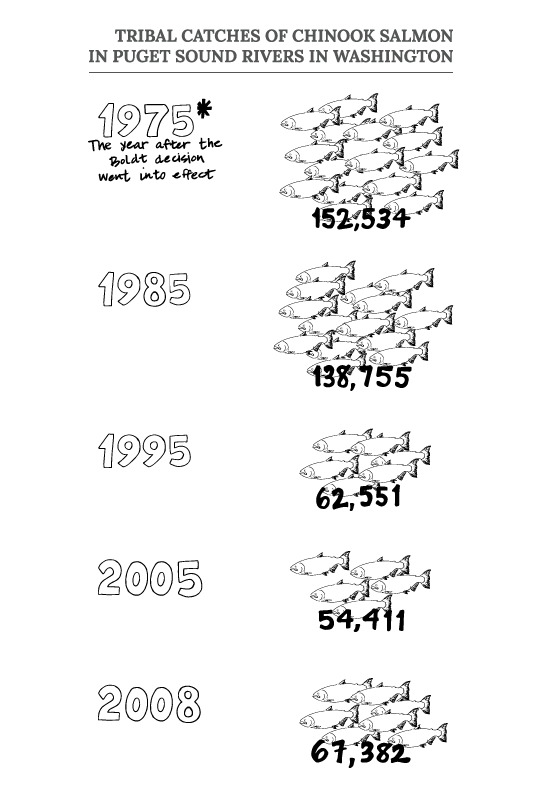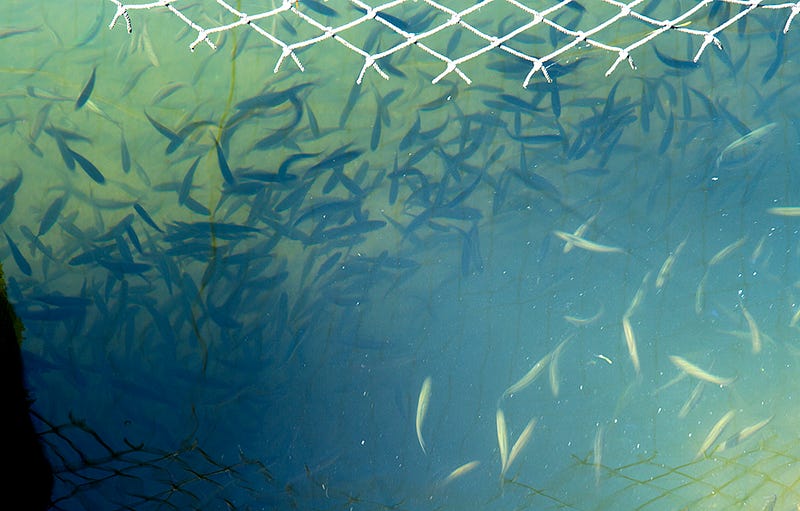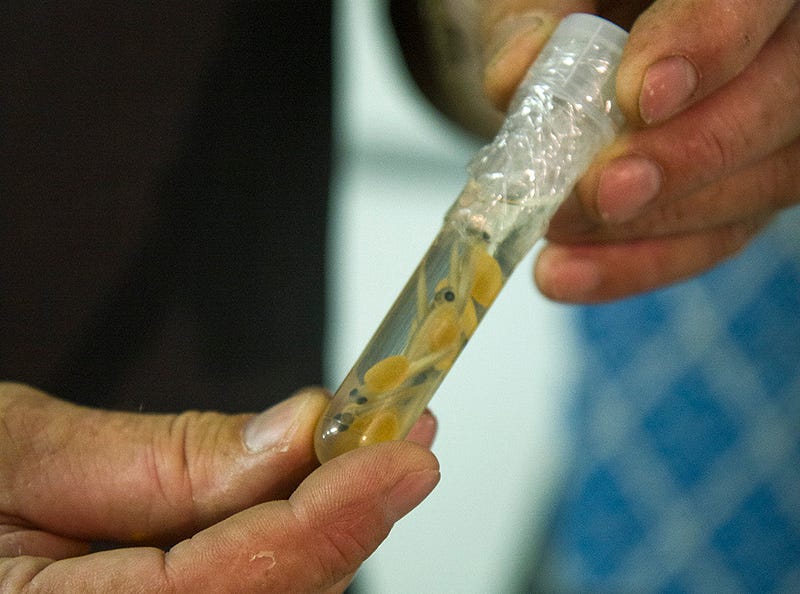Scaling Back
Habitat, fishing and restoring Northwest salmon
STORY BY BROOKE HANSON
photos by Annmarie Kent | infographic by Hannah Johnson
Native Americans have fished salmon in the Pacific Northwest for hundreds of years. Centuries ago, a delicate and balanced ecosystem was established where native tribes could harvest as much salmon as they needed. Salmon fishing continues to be critical for the economy and influential in cultural and spiritual aspects of some tribes in the Northwest. The annual return of salmon represents renewal and the continuation of human life. However, since modern industrialization and larger communities came to the area, the salmon populations have dwindled. The tribal salmon harvests have decreased as the salmon populations have decreased.
Native American salmon fishing in Western Washington is constrained by salmon endangerment because of habitat quality, which can be caused by pollution in the water. The endangered salmon in Washington are Chinook, Chum, Coho and Sockeye, according to U.S. Fish and Wildlife Services.
AFFECTS OF THE BOLDT DECISION
In 1974, Federal District Judge George Boldt ruled that natives have the right to 50 percent of the available salmon harvest. That 50 percent is subject to the fluctuating salmon population, and as the total population decreases, so does the volume of the native harvest. Forty years after the decision, fierce debates and political unrest continue.

Salmon fishing is a significant part of native culture, says Scott Schuyler, the fisheries manager for the Upper Skagit Tribe. Schuyler, 50, has been a tribal fisherman since he was a teenager, and has witnessed the effects of dwindling salmon populations.
“We reserve the right to fish for salmon to practice our culture and our way of life,” Schuyler says.
Tribes and the Washington Department of Fish and Wildlife work cooperatively to set fishing guidelines annually. They put guidelines on how many salmon can be fished each season by tribal fishers as well as non-natives.
Tony Meyer is the division manager for Information and Education Services at the Northwest Indian Fisheries Commission, a support service organization for federally recognized tribes in Western Washington. The decreasing salmon population directly affects the extent to which the tribes can exercise their rights, and the population is directly affected by the lack of salmon habitat, Meyer says. Since the entire salmon harvest is a smaller volume, the tribe’s 50 percent is smaller as well.
“We’re losing salmon habitat faster than we can fix it or protect it,” Meyer says. “We have to stop the bleeding in the watersheds.”
The habitat matters so much because it determines the quality of life the fish have, Meyer says. Without good water quality and a clean habitat, they can’t thrive.
“People point to a lot of things to place the blame,” Meyer says. “It’s time to repair the habitat so we can move forward.”
INCREASING THE SALMON POPULATION
The Skookum Creek Hatchery in Acme reeks overwhelmingly of fish. Sounds of birds chirping are often drowned out by the constant flow of water through ponds filled with millions of salmon. Bill Finkbonner, 64, and his crew work year-round to harvest salmon for the Lummi Nation.
“We’re losing salmon habitat faster than we can fix it or protect it. We have to stop the bleeding in the watersheds.”
Finkbonner has worked there since 1977 and knows every detail about the processes of the hatchery. They raise Coho and South Fork Spring Chinook, which come through Skookum Creek from the Nooksack River. The hatchery produces about 2 million Coho a year, Finkbonner says.
Skookum Creek Hatchery runs a recovery program for the South Fork Spring Chinook, which are threatened, Finkbonner says.
Under the Endangered Species Act of 1973, a species is considered endangered when it risks extinction throughout all or a significant portion of the species’ range, which is the habitat they live in. A species is considered threatened when it is likely to become endangered in the foreseeable future throughout all or a significant portion of their range.

HOW TO HELP THE FISH
In order to increase salmon population, Skookum Creek Hatchery takes eggs from the female Chinook and fertilizes them with sperm from the male Chinook. They incubate them, and then raise the fish in ponds for 90 to 100 days, Finkbonner says. When the fish are mature, they are released back into the South Fork Nooksack River.
In the first year of the recovery program, four years ago, the hatchery released roughly 1,900 spring Chinook. This year, hatchery workers released roughly 670,000, Finkbonner says. The goal is to release one million in a year, which could happen within the next few years if hatchery conditions continue like they have in past years. Once the hatchery reaches one million Chinook, they will scale back and let the population grow in nature. Though the Chinook are on their way to a healthier population, other species of salmon are still in decline.
Salmon released from the hatchery are free to be fished. All hatchery fish are marked by having their adipose fin removed, which is a few inches in front of the tail fin. If a fisher catches a marked fish, they are free to take it. If they catch a fish with the adipose fin, it is wild and is supposed to be put back in the water.
About 50 percent of the salmon in the Nooksack River were raised in a hatchery, Finkbonner says. The intention is that the salmon population will recover one day and hatcheries will no longer be needed.
“Our eventual goal is to turn it back over to Mother Nature, but I don’t know if that will ever be possible,” Finkbonner says.
HABITAT RESTORATION
One key problem is that the National Oceanic and Atmospheric Administration needs to exercise its authority to address the lack of healthy salmon habitat, Schuyler says. NOAA could do more to protect the habitat by enforcing existing habitat protection laws, he says.
“They are eager to curb the harvest, which is more political,” Schuyler says.

Even if all fishing stopped, some fish would go extinct, Meyer says.
“You can’t gain any more fish by cutting the harvest; you need to repair the habitat,” he says.
The administration does what it can for habitat restoration under the Endangered Species Act, but it doesn’t have direct authority, says Elizabeth Babcock, the Puget Sound salmon recovery coordinator at NOAA. The Endangered Species Act gives NOAA limited authority over habitat protection, she says. State and local governments have their own land use management regulations.
The Endangered Species Act directs NOAA to protect and recover endangered species and it implements those protections under what Babcock calls the three H’s: harvest, hatcheries and habitat.
NOAA and the tribes work together to make sure salmon recovery gets on track. The 20 treaty tribes in Western Washington started the Treaty Rights at Risk initiative in July 2011, which contributed to the start of a more coordinated salmon recovery effort.
Federal government, state government, local land use authorities and tribes are all working to repair habitat so salmon population will increase, Babcock says.
Salmon are an integral part of native culture and are a critical economic asset, according to the histories of local tribes. Western Washington tribes depend on a healthy salmon harvest each year. Long ago they developed rituals to celebrate the return of a plentiful salmon harvest. Today, they continue to celebrate the harvest, but it is not as plentiful as it once was. One day they hope to celebrate the true abundance of salmon again.
